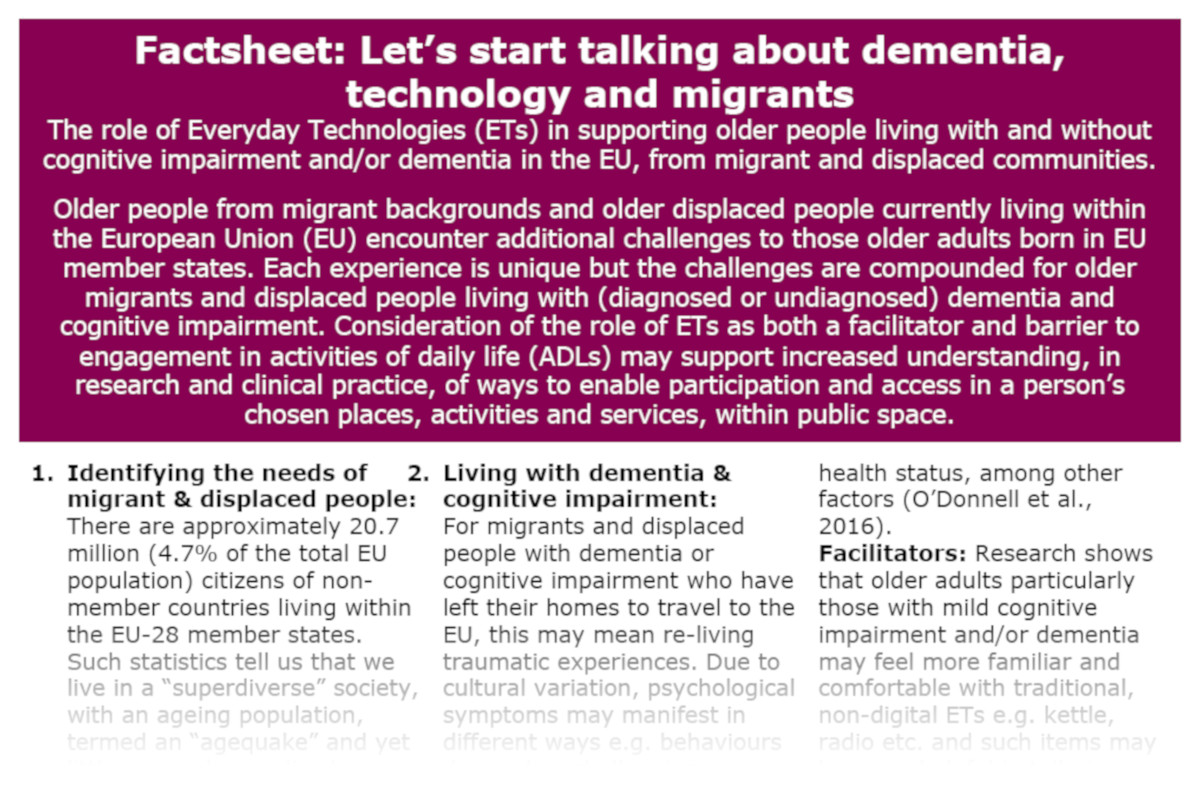Technology in everyday life
Guidance
Technology companies and developers should involve more diverse groups of people living with dementia or caring for people with dementia, in all stages of design, development and implementation of technologies. They should also consider existing contexts before introducing them.
Explanation and Examples
Consultations explored the ways in which Everyday Technology can be both an enabler and disabler, among people living with dementia, or providing care for people with dementia, from minority and migrant communities within the EU (Germany and Greece). The consultations highlighted the need for more contextually-relevant Everyday Technologies. This includes consideration of existing contexts before introducing technologies or technology interventions e.g. eHealth, finance or social apps. Consultees reported the need to identify existing levels of access and ability to use Everyday Technologies (e.g. possession of technological devices and digital literacy etc.) as well as access to infrastructures to support their use (e.g. internet connection, battery charging facilities and face-to-face support). Everyday Technology use is influenced by contextual and cultural factors. Technology companies and developers need to involve a more diverse group of people living with dementia or caring for people with dementia (e.g. from different cultural and socio-economic backgrounds, urban and rural environments etc.) throughout all stages of technology development.
Read more >
Guidance
Consider involving occupational therapists in providing interventions that enable people with dementia to use the everyday information and communication technologies they have.
Explanation and Examples
A standardized questionnaire mapped how many Everyday Information & Communication Technologies (EICT) (maximum 31) were relevant to 35 people living with dementia and 34 people with no known cognitive impairment in Sweden. A relevant EICT is one that is being used, or has been used in the past, or is planned for use in future. The median amount of relevant EICTs was shown to be 11 in the group without dementia, and 7 (significantly less) in the group with dementia. Each person also rated their ability to use (maximum 90) relevant Everyday Technologies (ETs) on a 5 step rating scale. This data was analysed (in a Rasch model) to produce a score for each person’s ability to use ET. When we compared ability to use ET with amount of relevant ETs in each group, the more EICTs a person counts as relevant, the higher was their ability to use ET. This pattern was only found in the group of people with dementia, and not the group without. The amount of relevant EICTs is affected by a person’s ability to use them. So some people may need support to identify the usefulness and possibility to use an EICT function that they have access to.
Read more >
Guidance
To avoid excluding some people with dementia, service developers should provide alternative non-ICT options when they deliver services and interventions that rely on smartphones, tablets and computers.
Explanation and Examples
A standardized questionnaire mapped how many Everyday Information & Communication Technologies (EICTs) (maximum 31) were relevant to 35 people living with dementia and 34 people with no known cognitive impairment in Sweden. In the same questionnaire, each person also rated their perceived their ability to use (maximum 90) relevant ETs on a 5 step rating scale. A relevant EICT is one that is being used, or has been used in the past, or is planned for use in future. This data was analysed (in a Rasch model) to produce a score for each person’s ability to use ET, and a challenge measure for each of the 31 EICTs to show how difficult or easy they were to use compared to each other. EICTs on smartphones and tablets were not relevant for a high proportion of both groups. Combined with a lower ability to use ET, particularly for people in the group with dementia, and high challenge measures for computer and automated telephone service functions, this could mean some people cannot access EICT-based services and interventions on computerized devices. However, the landline telephone was easiest to use and relevant to the majority of both groups, so this, together with face-to-face options could provide viable alternatives.
The study is currently under review and will be available under open access.
Read more >




